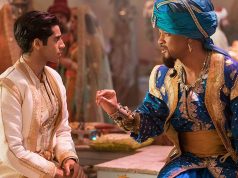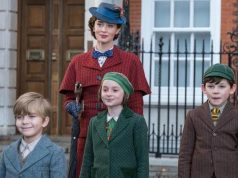Against all odds, and despite being the longest film in the series, “Pirates of the Caribbean: At World’s End” is probably also the best. It’s less chaotic and exhausting than “Dead Man’s Chest,” more emotionally engaging than “Curse of the Black Pearl.” For the first time, I can see why many people LOVE this series. If only the first two films had actually been as good as their box office haul suggested they were!
“At World’s End” begins with things looking grim for nearly everyone. Jack Sparrow (Johnny Depp) has been sent off to Davy Jones’ locker, which turns out to be not just a metaphor for “death,” but an actual location, albeit on a different spiritual plane and apparently rather difficult to return from. England’s Lord Beckett (Tom Hollander) is cracking down big-time on piracy, with mass public hangings scheduled daily. Young lovers Elizabeth Swann (Keira Knightley) and Will Turner (Orlando Bloom) have parted company for reasons that were probably explained in the last film (well, as much as anything can be said to have been “explained” in the last film) but that I do not recall.
Now Elizabeth and the resurrected Captain Barbossa (Geoffrey Rush) have traveled to Singapore to get a map to Davy Jones’ locker from Sao Feng (Chow Yun-Fat), the chief pirate captain of the Orient. Later, Elizabeth somehow winds up in Sao Feng’s possession due to the latter’s mistaken belief that she is the sea goddess Calypso in human form.
OK, I said this film is less chaotic than the last one, not that it lacks chaos altogether. The story is still jam-packed with double-crosses, betrayals, and secret negotiations, but it’s a much more linear, straightforward story than before. Only occasionally must one pause and say, “Wait, what?” Mostly you can just smile blithely and enjoy it.
This is especially surprising given how much there is going on. The central plot has the world’s pirate lords assembling to discuss how to repel the British crackdown, but that barely scratches the surface. We learn more about the mortal life of the now-cursed Davy Jones (Bill Nighy), as well as the backstory on the mystical voodoo priestess Tia Dalma (Naomie Harris). There are issues of pirate politics to deal with, and it’s nice to see that, unlike the United Nations, pirate summit meetings often end in fisticuffs and stabbings. Other subplots involve the rules surrounding the Flying Dutchman and how one becomes its captain, and why a person might want that.
Regular “Pirates” writers Ted Elliott and Terry Rossio were obviously paying attention on the day of screenwriting class that talked about character objectives. Every person in “At World’s End” has a very specific thing that he or she wants. Elizabeth and Barbossa want to retrieve Jack from Davy Jones’ locker; Will wants to free his father from servitude on Jones’ ship; Beckett wants to learn where the pirate council is being held; Davy Jones wants to restore his mortality; Jack wants to drink rum and sail the world. The film even has a prop to simplify this concept: a magic compass that always points toward the thing you want the most.
What isn’t always covered is why people want the things they want. The overall objectives I’ve just named are self-explanatory, but some of the smaller steps they take toward accomplishing those goals aren’t clear. For example, one character is put to death and I literally have no idea why. The person responsible for it obviously felt it would help him achieve his own goals, though, so more power to him, I guess.
But despite being plot-heavy like its predecessors, “At World’s End” is mostly coherent and fluid, and it manages to make us care about some of the characters on an emotional level, too. Director Gore Verbinski has always shown a keen eye for visual details and spectacular set pieces; here he combines it with some genuine heart and humanity. I’ve always liked Jack Sparrow as a character, but this is the first time I’ve liked him as a person, too.
It all leads to a rousing, vertiginous climax set aboard two ships in the midst of a maelstrom. Sure, the film goes on for another 30 minutes after that “finale” (the “Return of the King” syndrome), but restraint has never been a hallmark of this franchise. The jolly performances, the lavish production design, the peculiar details and whimsical asides — it all adds up to an enjoyable and cohesive swashbuckling adventure. It’s about time.
B (2 hrs., 48 min.; )





